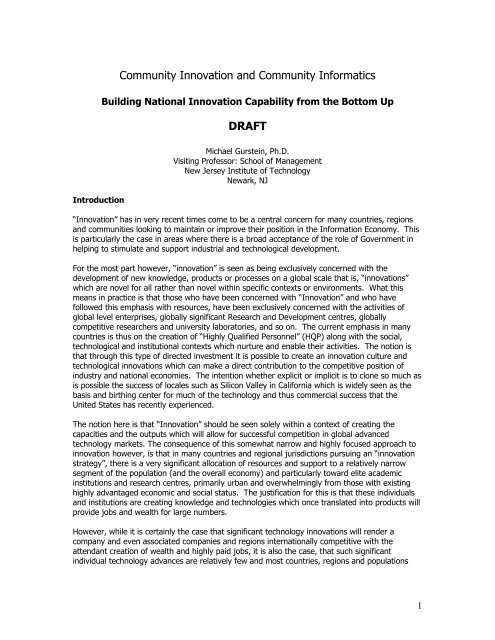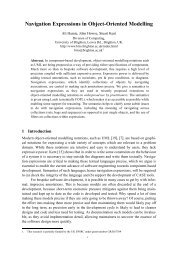Building National Innovation Capability from the Ground Up
Building National Innovation Capability from the Ground Up
Building National Innovation Capability from the Ground Up
- No tags were found...
Create successful ePaper yourself
Turn your PDF publications into a flip-book with our unique Google optimized e-Paper software.
approach, <strong>the</strong>re is a degree of assurance that <strong>the</strong> process of innovation will become an on-goingelement of community life and activity ra<strong>the</strong>r than a once for all investment in for example asingle high profile “innovating institution”.It is one of <strong>the</strong> crucial activities for Community Informatics to design appropriate strategies andtechnology supports for <strong>the</strong>se processes of knowledge acquisition, assimilation and processing.Similarly <strong>the</strong> provision of technical supports to communities in <strong>the</strong>ir processes of knowledgemanagement may be one of <strong>the</strong> most significant arguments in support of community focused ICTstrategies in that <strong>the</strong> fostering of innovation and innovative capacity at <strong>the</strong> local level is a majorsource of advance and a prime basis for economic and social development locally as well as apowerful contributor to national strategies for innovation.Thus <strong>the</strong> availability of technology supports at <strong>the</strong> local level can be seen as a significantcontributor to <strong>the</strong> opportunities for local innovation and <strong>from</strong> <strong>the</strong> perspective of nationalgovernments <strong>the</strong> investment in <strong>the</strong> development of local technology infrastructures may be seenwithin <strong>the</strong> overall context of a contribution to a national “innovation strategy”.Within this context it should be recognized however, that it is not sufficient simply to provideaccess to <strong>the</strong> technology. Simple access in <strong>the</strong> absence of an appropriate contextual set ofsupports and linkages may not necessarily lead into effective use xvi . Equally, since <strong>the</strong> intentionis not simply to link <strong>the</strong> local to <strong>the</strong> global or <strong>the</strong> national, but ra<strong>the</strong>r to provide <strong>the</strong> means forthose at <strong>the</strong> local level to respond at whatever level and in whatever means makes <strong>the</strong> mostsense in a particular context (of product, process, service etc.) it is crucial that <strong>the</strong> technology benot simply accepted, but ra<strong>the</strong>r “appropriated” i.e. integrated and assimilated by those locally soas to be amenable (provide <strong>the</strong> pre-conditions for) effective use in <strong>the</strong> manner most desirable.Social Learning and Human Capital DevelopmentCountries globally are looking for methods of creating or enhancing local human capital i.e. <strong>the</strong>capacity of individuals locally to learn and to undertake more or less complex productive tasksand to contribute to economic activity, particularly economic activity with a high skill orknowledge component. The development of “Human Capital” particularly in <strong>the</strong> context ofadvanced economies (or those who wish to become advanced economies) is a significant priorityfor government investment.One of <strong>the</strong> primary reasons for emphasizing human capital development is to provide a basis forinnovation at <strong>the</strong> local level recognizing that this innovation is often a necessary concomitant orco-existing factor with innovation at <strong>the</strong> regional or national levels as well. One of <strong>the</strong> mosteffective strategies for human capital development is through processes of social learning; thatis, where means are developed to support learning within a population not only through formalinstitutions such as schools and colleges but also through informal processes such as throughnon-governmental organizations, friendship groups and informal social groupsl.The relationship between human capital development and innovation is a complex one, in thatlearning as a basis for human capital development, <strong>the</strong> capacity to accomplish a wider range ofmore skill intensive tasks for example, may in turn lead to local innovation as <strong>the</strong> accomplishmentof those tasks may be “novel” within <strong>the</strong> local context—think about <strong>the</strong> anticipated impact ofleadership training within a relatively closed and static community where <strong>the</strong> leader is suddenlyenabled with skills at accessing and processing a suddenly much wider range of knowledge whichmay have immediate application within <strong>the</strong> local economic and social environment.8
But similarly, innovation may itself be <strong>the</strong> source of human capital development where forexample, <strong>the</strong> development or implementation of a new product or process locally requires orstimulates those locally to acquire new skills or to find a means to adapt existing skills andknowledges to <strong>the</strong> newly emerging sets of opportunities.In this context <strong>the</strong>n, innovation is a "social" as well as a "technical" process and "innovation" canoccur and be fostered to occur in communities as well as in say Universities or researchlabs. <strong>Innovation</strong> understood in this way is in turn linked to local economic and social development(and Human Capital Development).Similarly it can be understood that in this context technology supports human capitaldevelopment at <strong>the</strong> local level through training, knowledge creation/distribution, and also as asupport to innovation which in turn is linked both as a cause and an effect to local human capitaldevelopment. This kind of argument can <strong>the</strong>n provide a whole range of (politically useful)rationales for local investment in technology and can also suggest a number of fairly specificprogram activities and identifiable/measurable outcomes--something will probably be requiredsince <strong>the</strong>se are being provided as a public service,.Communities can thus be seen as <strong>the</strong> focal points for learning, for skill development for networkbuilding, and for resilience in life long learning and knowledge acquisition. xvii The challenge andopportunity that has recently emerged is that Information and Communications Technologies(ICTs) provide dramatically enhanced means for supporting <strong>the</strong>se types of developments. Wherepreviously those locally had to rely simply on available physical or human resources to support<strong>the</strong>ir learning or skill development, with <strong>the</strong> availability of very low cost Internet access this is nolonger <strong>the</strong> case and while appropriate content may not be immediately available <strong>the</strong> overallopportunity exists to enhance local learning with global resources based on an ICT technicalplatform.However, as has been noted elsewhere xviii simply making a facility available or accessible is notsufficient to ensure that it will be “effectively used” i.e. implemented and made use of. For thisto happen <strong>the</strong>re is <strong>the</strong> need for a number of elements to be in place in addition to <strong>the</strong> physicalinfrastructure of “access” and including an appropriate and appropriately designed and presentedcontent, and a welcoming and supportive social infrastructure sufficient to <strong>the</strong> application or inthis case <strong>the</strong> “learning” that is being provided.A Community Informatics approach to local technology implementation emphasizing as it does<strong>the</strong> articulation within <strong>the</strong> community of community goals for technology, community ownershipand deployment/management of <strong>the</strong> technology; <strong>the</strong> design and implementation of locallyresponsive strategies for implementation, training, content design; and <strong>the</strong> creation of a suitablesocial/community context and institution building to support <strong>the</strong> applications being presentedthrough <strong>the</strong> ICT infrastructure all will contribute to an effective process of community learningand community human capital development as a specific ICT community application.Social Efficiency/Social EffectivenessThe introduction of digital systems has had dramatic impacts on <strong>the</strong> efficiency and productivity ofconventional enterprise and <strong>the</strong> dramatic restructuring of Corporations and Governmentsredeveloped on digital platforms—enormous gains in efficiency, new products and in <strong>the</strong>“effectiveness” of existing products, new “business” (government) models. The argument isbeing made that <strong>the</strong> current very dramatic improvements in productivity in, for example, <strong>the</strong>economy of <strong>the</strong> United States are a direct product of <strong>the</strong> introduction of such systems as digital9
supply chain management, electronic purchasing, bar coded and now RFID logistics managementand so on.Overall, Management Information Systems (MIS) as a discipline and a practice has been of veryconsiderable support in <strong>the</strong> research, design, development and implementation of <strong>the</strong>se systemsand thus a significant contributor to <strong>the</strong>se efficiency gains. Currently through <strong>the</strong> introduction ofsystems to support knowledge creation, management, and distribution similar productivity gainsare being achieved in <strong>the</strong> area of services within <strong>the</strong> corporate economy. In addition, andnotably, not only have <strong>the</strong>re been significant gains realized as a result of technology in <strong>the</strong> areaof efficiency, <strong>the</strong>re have also been parallel and equally substantial gains in <strong>the</strong> redesign andredevelopment of products and services incorporating as a constituative element <strong>the</strong>opportunities that advanced technologies afford. One need think only of <strong>the</strong> redesign ofautomobiles to incorporate sensors, dynamic processors, and new materials and so on to make<strong>the</strong> modern automobile more energy efficient, safer and more streamlined, as an example.Overall however, services directed toward supporting individuals and communities outside of <strong>the</strong>corporate environment have lagged considerably in <strong>the</strong>ir achievement of productivity. Even moresignificantly human focussed social services have lagged in <strong>the</strong>ir redesign so as to reflect <strong>the</strong> newopportunities which technologies present. As publicly supported human services suffer as aresult of changing government funding priorities, ra<strong>the</strong>r than look to technology as a means ofmaintaining or even enhancing <strong>the</strong>se services through an effective redesign and redevelopmentto achieve efficiencies and enhanced effectiveness, <strong>the</strong>se services are being allowed to whi<strong>the</strong>rthrough a lack of investment and attention.It may be time to “flip <strong>the</strong> argument over” and ra<strong>the</strong>r than looking for <strong>the</strong> means to continue toprovide increasingly expensive services <strong>from</strong> <strong>the</strong> context of central management, organizationand delivery (<strong>the</strong> industrial model) with productivity oriented investments directed only atenhancing <strong>the</strong> capacity at <strong>the</strong> point of central management perhaps it would be more useful tothink of <strong>the</strong>se services <strong>from</strong> <strong>the</strong> perspective of <strong>the</strong> end user and his or her family and communityas <strong>the</strong> focus for additional investment and to identify means by which <strong>the</strong>se services can bemade available more efficiently and presumably as or more effectively to end users within <strong>the</strong>context of an “effective use” approach.There are dramatic gains/benefits to be found in both efficiencies and in effectiveness forcommunities and for society as a whole in Effective Use/Community Informatics applications –e.g. Community based e-health, community based resource management, communitygovernance and locally based community watch/security programs. Think for example of <strong>the</strong>development and implementation of ICT enabled programs for community support of an agingpopulation. Ra<strong>the</strong>r than relying solely on “professionals” as care givers, a program could bedesigned to inter-link with <strong>the</strong> variety of requirements for senior care-giving including localsensors and diagnostics, smart analytical tools for integrating diagnostics, on-line communitysupport tools for chronic or critical care-givers, social support tools for isolated individuals andisolated care-givers. Additionally programs for an aging population could provide technologysupports for community participation, community response to emergency and routinehealth/monitoring activities for seniors, information programs to support care givers and semiindependentseniors and so on.As ano<strong>the</strong>r example <strong>the</strong>re is <strong>the</strong> redesign of health services, based on providing support toindividuals, families and communities to deliver <strong>the</strong> range of health service that can be easilyaccommodated and provided in a self-care mode. This would almost certainly have a significanteffect both on <strong>the</strong> efficiency (and thus on <strong>the</strong> overall cost of <strong>the</strong> provision of health) as well as on<strong>the</strong> effectiveness of <strong>the</strong> health care system by making service(s) much more widely availablethan currently to those unable to access services ei<strong>the</strong>r because of cost or location.10
The creation of a suitable context at <strong>the</strong> local level for such a transformation would require veryextensive developments in <strong>the</strong> creation of a local supportive technology social infrastructure asfor example, through <strong>the</strong> build out of existing community technology facilities throughCommunity Access sites, local technology centres, and broadband management organizations,and so on. The introduction of <strong>the</strong>se types of applications would require a very extensivecapacity for innovation and adaptation at <strong>the</strong> community level as <strong>the</strong>re would be a very broadrange of new skills required and novel responses to traditional activities and services. Thecreation of “community innovation systems’ as <strong>the</strong> basis for <strong>the</strong> introduction of such strategieswould appear to be <strong>the</strong> most effective approach. The effort and expense involved in suchdevelopments would almost certainly be warranted and cost justified given <strong>the</strong> increase in servicedelivery productivity and effectiveness which would result.For <strong>the</strong>se purposes <strong>the</strong>re would be a significant up-front cost, but <strong>the</strong>se costs would quickly beamortized over large numbers of users and <strong>the</strong> resulting savings for social support costs andincluding health support costs could be highly significant perhaps on <strong>the</strong> scale of <strong>the</strong> kinds ofcost-savings achieved through <strong>the</strong> implementation of electronic platforms for commercial supplychains.The requirement to implement <strong>the</strong>se types of systems at <strong>the</strong> local level and including achieving<strong>the</strong> kinds of social, organizational and behavioural change/acceptance required for effective usewould be substantial but should be seen as an element and an out-growth of <strong>the</strong> creation of aninnovation capacity at <strong>the</strong> local level. The capacity to absorb and utilize technology andtechnology mediated information and services will be a central element in achieving <strong>the</strong> kinds ofsocial efficiencies and increased program/service delivery effectiveness which is possible, butachieving <strong>the</strong> capacity to realize <strong>the</strong>se types of innovation at <strong>the</strong> local could and would havehighly significant benefit in terms of overall social costs and social well-being.Social Equity, Inclusion and <strong>the</strong> Digital DivideICTs are <strong>the</strong> production tools of <strong>the</strong> Information Society. “<strong>Innovation</strong>” is one of <strong>the</strong> motors thatare driving <strong>the</strong> use and application of ICTs and in this way driving <strong>the</strong> creation of value within <strong>the</strong>New Economy/Information Society. Clearly <strong>the</strong> primary sources of <strong>the</strong> innovations that areoccurring within <strong>the</strong> Information Society are being largely driven by private sector research,development and commercial interest and competition. However, a large amount of <strong>the</strong> researchand development on which this innovation is based comes <strong>from</strong> publicly supported research labs,universities, and ultimately is based on a background in <strong>the</strong> public domain of existing knowledge,culture and language.An almost irrefutable argument can be made, <strong>the</strong>refore, that access to <strong>the</strong> resources and toolswhich enable innovation – <strong>the</strong> technology infrastructures, <strong>the</strong> learning and knowledge, <strong>the</strong> socialframeworks – should be accessible to those without <strong>the</strong> backing of commercial resources so that<strong>the</strong>y may also derive benefits <strong>from</strong> <strong>the</strong> application of ICTs toward <strong>the</strong> resolution of local andcommunity concerns equally with commercial applications.The notions and discussions around <strong>the</strong> “Digital Divide” have largely focussed on issues of“access” and particularly access to ICT tools and infrastructure. xix However, it could well beargued that <strong>the</strong> more serious “divide” is not between those with and without “access” but ra<strong>the</strong>rbetween those who have available <strong>the</strong> means to “innovate” and apply/effectively use ICTs in<strong>the</strong>ir local circumstances and linked to local issues and concerns, and those who do not. It couldfur<strong>the</strong>r be argued that those without effective access to those tools i.e. <strong>the</strong> means and <strong>the</strong>11
opportunity to use those tools in productive and useful ways are relegated to being unable toparticipate in <strong>the</strong> fastest growing, best paid sectors of <strong>the</strong> economy.Also, since ICTs are <strong>the</strong> learning tools of <strong>the</strong> Information Society, those without effective accessto those tools i.e. <strong>the</strong> means and <strong>the</strong> opportunity to use those tools in support of learning arerelegated to being unable to participate in <strong>the</strong> most intensive social learning processes andnetworks; and since ICTs are increasingly <strong>the</strong> decision-making tools of <strong>the</strong> Information Societythose without effective access to those tools i.e. <strong>the</strong> means and <strong>the</strong> opportunity to use thosetools in support of participation in decision making processes are relegated to being unable to beactive citizens in contemporary democratic processes<strong>Innovation</strong> in Less Developed CountriesIt is notable that most of <strong>the</strong> discussions on <strong>Innovation</strong> and Economic Development have beenconcerned with already developed economies and industrial infrastructures. However, it ispossible that <strong>the</strong> real opportunity for innovation and for having major impacts as a result of aninnovation strategy is in enabling Less Developed Countries (LDCs) to leap-frog directly into aKnowledge Based Economy <strong>from</strong> a more traditional economic base.The possibility of this type of “leap-frogging” is greatly increased because of <strong>the</strong> wide spreadopportunity for acquiring a state of <strong>the</strong> art Information and Communications Infrastructuresimilar (equal) to <strong>the</strong> infrastructure which is enabling industrial innovation in more advancedcountries and economies. In this case <strong>the</strong> introduction of a state of <strong>the</strong> art ICT infrastructurepresents to national economies opportunities for <strong>the</strong> development of a national innovativecapacity parallel in this respect at least with that which exists in its much more advancedcompetitors.Similarly, <strong>the</strong> increasing mobility of individuals as students or faculty or researchers has meantthat many LDCs may have access to highly qualified nationals or even expatriates who canprovide some of <strong>the</strong> human capital necessary to support innovation at <strong>the</strong> national level. Thechallenge for <strong>the</strong>se countries however, is that while <strong>the</strong>re may be a limited capacity forinnovation and <strong>the</strong> development of innovative firms at <strong>the</strong> national level and in <strong>the</strong> capital, thismay be detached <strong>from</strong> <strong>the</strong> broader requirements for innovation and economic development inrural and non-capital urban areas, where <strong>the</strong> bulk of <strong>the</strong> population and particularly <strong>the</strong> poorerpopulation are residing.<strong>Innovation</strong> and Public Internet Access (Local technology centres) in LDC’sIt should be quite clear that creating a small pocket of world competitive firms in <strong>the</strong> capital cityof a LDC which is completely detached <strong>from</strong> local requirements and concerns outside of this“pocket” may not be sustainable in <strong>the</strong> medium and longer term. The challenge for <strong>the</strong>se LDCs isto find ways of enabling and supporting “innovation” and “innovative practices” beyond <strong>the</strong>national capital and beyond <strong>the</strong> relatively small group of those with already established links andknowledge of international conditions and opportunities and even of linking <strong>the</strong> “pocket” in <strong>the</strong>capital with innovation systems and processes at <strong>the</strong> local level which are driving local changeand development and which in turn may be presenting interesting and useful challenges for <strong>the</strong>broader and elite innovation systems.It is into this niche that <strong>the</strong> local technology centres and o<strong>the</strong>r institutional strategies forachieving local or community technology access can be placed and which it can be argued, give<strong>the</strong> local technology centres <strong>the</strong>ir overall challenge, responsibility and opportunity. One way to12
approach this is by linking <strong>the</strong> national ICT and Development strategy (an implicit if not anexplicit “<strong>Innovation</strong>” strategy) directly to <strong>the</strong> implementation of a network of community basedICT centres. This approach appears to be very uncommon although it would seem anappropriate means for more widely disseminating <strong>the</strong> opportunities for “innovation” to <strong>the</strong> locallevel and potentially to be <strong>the</strong> next step in ICT for Development strategies (and for finding waysof obtaining a return on investment in Local technology centres).Constraints on Local <strong>Innovation</strong>Local innovation doesn’t just happen! There are many constraints to innovation happeningspontaneously at <strong>the</strong> local level.There are social constraints that result <strong>from</strong> community norms based on local cultures thatsupport existing practices and resist change. There is <strong>the</strong> fear of ridicule or “standing out”(sometimes called <strong>the</strong> “tall poppy phenomenon) where conformity itself becomes <strong>the</strong> norm andinnovation of whatever kind is seen as a form of opposition to this conformity.There are financial constraints to local innovation since innovation implies risk and that in turnreplies have <strong>the</strong> spare resources to manage and survive risk. Many, if not most in poorer localcommunities don’t have access to “risk” resources that allow for experimentation and <strong>the</strong>possibility (even likelihood) of failure.And <strong>the</strong>re are psychological constraints against local innovation in that <strong>the</strong>re is a comfort and asupport in doing things as <strong>the</strong>y have always been done, even if <strong>the</strong> result is poverty and a lack ofopportunity for oneself and one’s children.Stimulating <strong>Innovation</strong><strong>Innovation</strong> or <strong>the</strong> “creation of something new” is a result of certain conditions in <strong>the</strong> immediateenvironment:• Business Intelligence--knowledge of developments elsewhere• knowledge of best practices• knowledge of opportunities• diversity of people, ideas, information, perspectives• openness to change and tolerance• flexibility• creativityThe challenge in <strong>the</strong> context of <strong>the</strong> local technology centres is how to create an environment oratmosphere in which <strong>the</strong>se conditions may be found and <strong>the</strong> challenge overall for <strong>the</strong> localtechnology centres is how to create on a national level a system which supports and enableslocal innovation.The Institutional Context<strong>National</strong> LevelAn overall approach is to look at <strong>Innovation</strong> and o<strong>the</strong>r aspects of <strong>the</strong> local technology centres atthree levels, national (policy, budget, administration); network (horizontal peer to peerconnections between <strong>the</strong> local technology centre working through regional focal points/network13
hubs); and <strong>the</strong> local. The challenge is to develop an institutional framework which can supportlocal innovation and to do that <strong>the</strong>re needs to be enabling structures at all levels including <strong>the</strong><strong>National</strong> (program) level, regional levels and local levels.At <strong>the</strong> national level <strong>the</strong>re must be (as <strong>the</strong>re clearly is currently in only a few countries)recognition that local innovation is a necessary and constituent element in all aspects of nationalinnovation. Thus for example, <strong>the</strong> national innovation strategy will be designed so that it cannotbe “hi-jacked” by special interests for example to support exclusively high profile nationalresearch labs, university research or faculty/student recruitment programs, or contributions toprivate sector research initiatives. While each of <strong>the</strong>se is important and even necessary in <strong>the</strong>context of national innovation, <strong>the</strong> direct contribution that each of <strong>the</strong>se approaches makes tolocal innovation is slight at best. Also, <strong>the</strong> potential budget draw for <strong>the</strong>se “national” projects isvery large and in o<strong>the</strong>r cases globally <strong>the</strong>y have had <strong>the</strong> political influence at <strong>the</strong> national level tocrowd out investment in more locally focused innovation supports.In some respects, <strong>the</strong> most useful role for <strong>the</strong> national level agencies in this context is to providea voice for local innovation in <strong>the</strong> context of national budgets and national planning and prioritysetting and to create and support over <strong>the</strong> longer term, <strong>the</strong> o<strong>the</strong>r institutional and programmaticsupports for local innovation which will be organizational focused at <strong>the</strong> regional and local levels.Network (Regional) LevelAdditionally, we see <strong>the</strong> individual local technology centres stimulated and linked technically,organizationally, and socially in such a way as to form a national inclusive and dispersed networkof all <strong>the</strong> affiliated (affiliating) local technology centres. This network would for many purposesfunction so as to enable peer to peer relations, local technology centre to local technology centreand programs and resources should be made available to support this. It is out of <strong>the</strong>se types ofpeer to peer relations that much of <strong>the</strong> requirement for localized business intelligence, diversity,access to a broad range of localized knowledge, and <strong>the</strong> need to create local partnerships, willcome.Attention will need to be paid to ensure that <strong>the</strong> network functions as an open and engagingenvironment and that some of <strong>the</strong> natural tendencies towards local to local competition (as forexample, might through oversight be built into budgets) is avoided. The tendency towards cooperationshould not be avoided, it is a great stimulant to participation and involvement butshould ra<strong>the</strong>r be channeled towards longer term system affiliation, collaboration and “teamspirit”.Regional hubs might be established to work on a continuing basis to stimulate peer to peerinteraction between individual local technology centres and most importantly to be continuouslyobserving activities at <strong>the</strong> local centre and providing resources (human, financial, technical) asmight be needed to stimulate and support innovation as might be required. Thus for example,<strong>the</strong> regional hub should be developing and implementing strategies for enabling brainstorming,directed idea development, focused play all as pre-conditions for <strong>the</strong> development locally ofinnovative ideas and strategies. They should be continuously scanning <strong>the</strong> national, regional andglobal business environment for ideas and opportunities that might be introduced locally. Theyshould be in continuing contact with local centres and aware of ideas as <strong>the</strong>y might emergelocally and ready with a variety of techniques to help support <strong>the</strong> development of <strong>the</strong> idea <strong>from</strong>its first tentative stage into a more fully developed enterprise concept.Following on <strong>from</strong> this <strong>the</strong> regional hubs should have access to <strong>the</strong> range of skills and resourcesrequired to support <strong>the</strong> development of a business plan including financial resources as might be14
available. As well <strong>the</strong> regional hub should be a place where those locally wishing to moveforward in <strong>the</strong> use of <strong>the</strong> Net to support local development might go so as to extend <strong>the</strong>ir skillsand range of influence and operation. In that sense, <strong>the</strong> hub should be relatively open toaffiliation and participation by a variety of local agencies and individuals and have some modestresources available to support individuals or agencies as <strong>the</strong>y might choose to develop <strong>the</strong>irideas. In most cases <strong>the</strong> amount of resources required is very modest, ra<strong>the</strong>r what is useful is bymaking resources available, <strong>the</strong> network is acknowledging to <strong>the</strong> individual and to his/hercommunity that <strong>the</strong> idea is a “valued” one! These resources also reduce <strong>the</strong> risk to individuals ingiving time and energy towards innovations that might prove unsuccessful.In relation to that <strong>the</strong> regional hub should have access to more specialized skills technical andbusiness development skills as well as maintaining an active network of connections to muchmore specialized expertise in areas of potential interest both nationally and internationally. Infact, one of <strong>the</strong> “core competencies” of <strong>the</strong> regional hubs should be precisely this type ofnational, regional and global networking and this would be one of <strong>the</strong> major contributions that<strong>the</strong>y would make overall to <strong>the</strong> network and to individual centres as <strong>the</strong>y develop.Local LevelA prime responsibility of <strong>the</strong> regional hubs will be to provide on-going stimulation and support toinnovation and <strong>the</strong> development of an innovative capacity at <strong>the</strong> local level. In doing this it willbe required to find <strong>the</strong> means to enable within <strong>the</strong> local technology centres, <strong>the</strong> variety ofelements that go into innovation and innovative capability.Business IntelligenceDeveloping <strong>the</strong> capacity at <strong>the</strong> system level for routinely ga<strong>the</strong>ring information aboutdevelopments and innovations that are happening globally that might be applied or haveapplication through <strong>the</strong> local technology centre network. This process of environmental scanningcould be set up as a routine function of <strong>the</strong> R&D facility. Associated with this would be a meansfor routinely disseminating this information through <strong>the</strong> entire network of centres and wheresuitable <strong>the</strong> undertaking of R&D on some of <strong>the</strong> ideas or innovations identified in this scanningprocess to “localize” <strong>the</strong>se for application within country or <strong>the</strong> region.Best PracticesExisting activities as linked to <strong>the</strong> local technology centre would be identified and <strong>the</strong>n subject toa review of how <strong>the</strong>se were conducted elsewhere with an identification of regional andinternational best practices. This could begin with <strong>the</strong> training programs which could bebenchmarked against similar training programs in o<strong>the</strong>r jurisdictions internationally. Specifically in<strong>the</strong> case of <strong>the</strong> training program, ra<strong>the</strong>r than benchmarking <strong>the</strong> specific training, it might bepreferable to benchmark <strong>the</strong> desired outcome of <strong>the</strong> training which is providing skills for technicaljobs.Opportunities IdentificationIn many cases people don’t know what <strong>the</strong>y don’t know, so it is thus necessary to bring intoawareness <strong>the</strong> nature of <strong>the</strong> opportunities that might be available. The presentation locally of“clinics” where technology opportunities, business opportunities using technology, techniques forusing <strong>the</strong> technology are presented with examples and case studies should be developed. Thisgoes beyond training to link training into <strong>the</strong> identification of new opportunities and ways ofapplying <strong>the</strong> training for local enterprise development.Diversity15
Having access to a wide range of knowledge and experience including cultural variety, a range ofsocial contexts and networks, individuals and groups with substantial skills and experience in anumber of commercial or o<strong>the</strong>r contexts, a wide access to a range of information sources and soon is a significant pre-condition for local innovation in that it provides those at <strong>the</strong> local level witha range of possible courses of action and responses to new opportunities and challenges. To adegree an ICT platform can provide access to some of this diversity by linking local communitiesinto a diversity of information sources, knowledge bases and cultural and intellectual/scientificproducts and processes. In addition and perhaps of equal or greater importance <strong>the</strong> ICT platformcan link local communities into broader social networks along lines of common interest or sharedactivities through which knowledge may be exchanged and created and by means of which adiverse range of formal and tacit knowledge can be directly accessed for application to localcircumstances.Openness to Change and ToleranceAssociated with access to diversity is <strong>the</strong> capacity to accept and respond to diversity includingdiversity of cultural forms, social and religious practices, social values and <strong>the</strong> simple diversity of<strong>the</strong> range of human expression which has emerged in all parts of <strong>the</strong> world. This openness tochange and acceptance i.e. tolerance of diversity is in many aspects a pre-condition forinnovation in that it is through this tolerance and acceptance comes <strong>the</strong> openness forexperimentation and adaptation of new knowledge to existing circumstance which is <strong>the</strong> essenceof innovation at <strong>the</strong> community level.Creativity“Creativity” in many respects may be understood as <strong>the</strong> capacity to innovate as found withinindividuals ra<strong>the</strong>r than groups. In that sense, creativity is a characteristic of individuals whichincorporates many of those characteristics which we have above identified as being elements of“innovation”. Creativity in individuals involves <strong>the</strong> capacity to revise, reformulate, and re-pattern(and so on) existing contexts, materials, ideas and strategies. While some argue that creativity isan inborn mechanism which cannot be “taught”, o<strong>the</strong>rs suggest that <strong>the</strong>re are strategies, if notfor building creativity within individuals, at least in provoking individuals and groups to developnew strategies and responses in relation to existing circumstances—an outcome of creativity,whatever <strong>the</strong> input sources. In any case, strategies for provoking creativity and “creativeresponses” to local circumstances should be undertaken.Conclusion: <strong>Innovation</strong> <strong>from</strong> <strong>the</strong> Bottom <strong>Up</strong>As previously defined, <strong>the</strong> basis of “innovation” includes among o<strong>the</strong>rs characteristics:• novelty• experimentation• ideas and imagination• shifts in attitudes• <strong>the</strong> development of new products• <strong>the</strong> development of new processesWhile in most instances, <strong>the</strong>se characteristics/attributes have been examined and promoted in<strong>the</strong> context of national systems and enterprises, <strong>the</strong>re is in principal no reason why <strong>the</strong>y couldnot (with much more modest expectations) be equally understood as being possible anddesirable in local systems and local enterprises. While <strong>the</strong> “novelty” or “experimentation” beingworked upon at <strong>the</strong> local level, may simply be “novel” or “experimental” for this community or forthis local region, never<strong>the</strong>less it does represent “innovation” and equally it is a way of identifyingand developing enterprise and service opportunities for that locale and that region.16
Similarly, creating an atmosphere which enables <strong>the</strong> development locally of ideas and imaginativeexploration stimulated by technological opportunities or by an observation of technologically(ICT) mediated experiences, best practices and innovations <strong>from</strong> elsewhere presents a powerfulplatform for local “innovation” and development. Among o<strong>the</strong>r areas, it stimulates and supports<strong>the</strong> development of attitudes toward technology, and economic and social opportunity which is<strong>the</strong> pre-condition for local innovation but even more importantly is a necessary constituentelement and support for a shift in national attitudes and cultural expectations concerningeconomic and social innovation.The experience in <strong>the</strong> developed countries has been that it is precisely <strong>the</strong>se attitudes andcultural predispositions toward innovation which are <strong>the</strong> necessary background for <strong>the</strong>development of a culture out of which new products and services may emerge and findacceptance in local markets preliminary to becoming competitive in <strong>the</strong> global or regionalmarketplace. Thus finding a method for stimulating similar kinds of changes at <strong>the</strong> local level inLDC’s and elsewhere and particularly in finding a means for having <strong>the</strong>se changes widelydispersed throughout <strong>the</strong> local areas is potentially of very great significance in achieving asustainable system of “innovation” at <strong>the</strong> national level and this is precisely <strong>the</strong> niche that <strong>the</strong>local technology centre can be seen as potentially occupying in <strong>the</strong> national and local KnowledgeEcology.The efforts at enabling innovation at <strong>the</strong> local level through local technology centres <strong>the</strong>n can beseen as equal partners in <strong>the</strong> creation of <strong>the</strong> national innovation system (IS) and strategies tosupport <strong>the</strong> national system should thus be directed equally to support <strong>the</strong> IS at <strong>the</strong> local levels.In this context <strong>the</strong> support for national R&D would find its counterpart in support for local R&D orat least R&D which is regionally focused and concerned with creating and supporting <strong>the</strong> bringinginto operation of locally and regionally innovative models, products and services.In this context as well, <strong>the</strong> recruitment, placement and creation of appropriate structures ofincentives for Highly Qualified Personnel at <strong>the</strong> national level should be seen as having anecessary counterpart at <strong>the</strong> local level through for example, <strong>the</strong> local technology Managers andTrainers.Also, <strong>the</strong> creation and on-going public support for institutions such as Universities, Colleges,Research Labs and so on which provide an on-going Knowledge and Research platform fornational level innovation should be replicated initially at least at <strong>the</strong> regional level as supports forlocal innovation through local technology centres. This could be done through <strong>the</strong> creation ofregional R&D centres linking into regional networks of local technology centres and perhapswhere suitable linking into regionally focused labs/centres in regional Universities or Colleges.As well, <strong>the</strong> creation of innovation supporting networks linking highly qualified personnel (HQP),R&D and innovative enterprises at <strong>the</strong> national level should equally be seen as having a veryuseful counterpart at <strong>the</strong> local/regional level in linking HQP, R&D and innovative enterpriseslocally and regionally.In addition, as <strong>the</strong> analysis and understanding of strategies of support for innovation emergeglobally (<strong>the</strong>re is an enormous amount of research activity being undertaken in this area at <strong>the</strong>moment), it should be <strong>the</strong> responsibility of <strong>the</strong> Agency guiding <strong>the</strong> development of <strong>the</strong> localcentres to find appropriate means for adapting <strong>the</strong>se (generally) nationally focused strategies tolocal and regional requirements in <strong>the</strong> LDC or elsewhere.Endnotes17
iThe discussion which follows has been significantly enhanced and informed by <strong>the</strong> multiple contributions and multiplecontributors to on-going discussions on <strong>the</strong> topic of “ICTs and Local <strong>Innovation</strong>” on <strong>the</strong> two email list,“communityinformatics” and “CIResearchers” both @vancouvercommunity.net. While <strong>the</strong> influences are many I haven’tset out to specifically summarize this discussion but I would strongly urge <strong>the</strong> reader to examine this discussion in <strong>the</strong>archives of <strong>the</strong> two e-lists for <strong>the</strong> period Nov.’03 to Jan. 04 athttp://vancouvercommunity.net/lists/arc/communityinformatics andhttp://vancouvercommunity.net/lists/arc/ciresearchersiihttp://www.hyperdictionary.com/dictionary/innovationiiihttp://www.<strong>the</strong>freedictionary.com/innovationiv http://canadianeconomy.gc.ca/english/economy/innovation.htmlv cf. Canada’s <strong>Innovation</strong> Strategy http://www.innovationstrategy.gc.ca/gol/innovation/interface.nsf/engdocBasic/3.htmlviGovernment of Canada, Achieving Excellence, 2002, Statement of <strong>the</strong> Ministerhttp://www.innovationstrategy.gc.ca/gol/innovation/interface.nsf/vSSGBasic/in02424e.htm#industryviiibid.viiiRichard Florida, The Rise of <strong>the</strong> Creative Class: And How It’s Transforming Work, Leisure, Community, and EverydayLife, Harper Collins, Boston, 2002.ix cf. for example Van Lieshout, Marc, Egyedi, Tineke M. & Bijker, Wiebe E. editors. Social learning technologies. Theintroduction o f multimedia in education. Aldershot: Ashgate Publishing, 2001.x Cf. for example <strong>the</strong> work on Communities of Practice by Etienne Wenger and o<strong>the</strong>rs; see E. Wenger, Communities ofPractice: Learning, Meaning, and Identity, Cambridge University Press, New York, 1998xiAdapted <strong>from</strong> M. Gurstein, “A Community <strong>Innovation</strong> System: Research and Development in a Remote and RuralCommunity”, in D. Wolfe and A. Holbrook (Eds.), Knowledge, Clusters and Regional <strong>Innovation</strong> Systems, Queen’s-McGillUniversity Press, 2002xiiFor a more complete discussion of <strong>Innovation</strong> systems in this context see M. Gurstein, (2002) op.cit.xiiiFor a more extensive discussion of <strong>the</strong>se points see M. Gurstein (2002) op.cit.xiv cf. M. Gurstein, http://www.firstmonday.dk/issues/issue4_2/gurstein/ and M. Gurstein, “Community Informatics,Community Networks and Strategies for Flexible Networking” in Community Informatics: A Social Agenda for Technology,Brian Loader and Leigh Keeble (Eds.) Routledge, London, 2001.xv cf. M. Gurstein, Community Informatics: Current Status and Future Prospects - Some Thoughts, Community TechnologyReview, Winter-Spring 2002 http://ctr.dyndns.org/article.php?article_id=56xviM. Gurstein, “Effective Use: A Community Informatics Strategy Beyond <strong>the</strong> Digital Divide”, First Monday, December2003. http://www.firstmonday.dk/issues/issue8_12/gurstein/index.htmlxviiM. Gurstein, “Community Learning, Community Economic Development and <strong>the</strong> New Economy”, a consulting report forHuman Resources Development CanadaxviiiM. Gurstein, “Effective Use…:” op.cit.xix op.cit18












